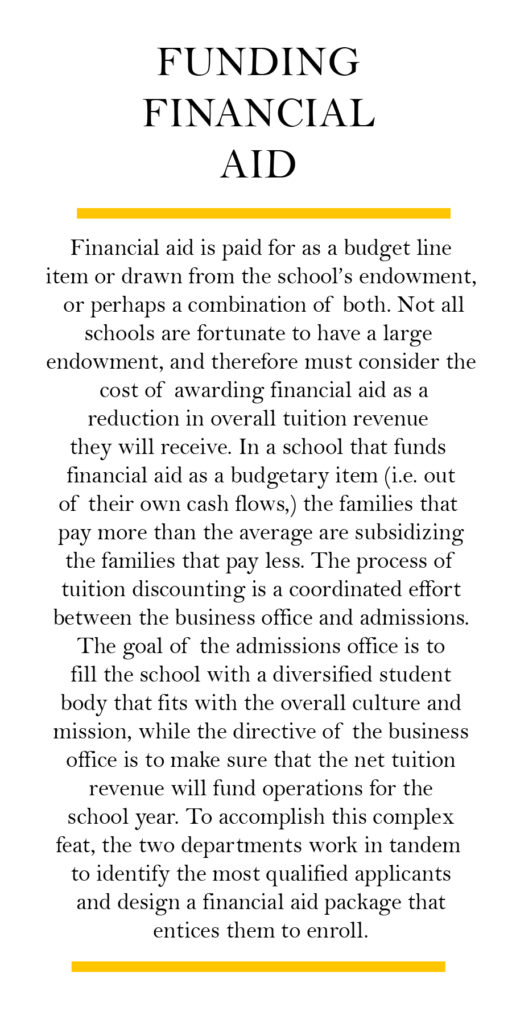Rebranding of Financial Aid: A Primer

This article also appeared on NetAssets.com December 9th, 2019.
Consumers have been trained to believe that higher cost items are synonymous with higher quality, and education is no exception. Families who choose an independent school education for their children generally believe that the scholastics and experience are superior to what’s available in the public-school sector. In an effort to keep up with one another and attract applicants, independent schools continue to offer new technology, facilities and programs, raising tuition rates along the way to fund each new project.
For a growing number of schools, tuition prices have risen sharply over the past few decades. The result is that, on average, private school tuition now takes up a larger percentage of household income than ever before. We are approaching a tipping point where nearly every potential student will require some form of discounting to be able to afford a private education. As tuition reaches new heights, “sticker shock” is becoming a problem and parents are beginning to wonder: is the education these schools deliver really worth the skyrocketing costs?

Tuition affordability is key to maintaining a diverse student population. The primary tool for enhancing socioeconomic diversity has been financial aid and tuition discounts, which allow qualified students from all economic backgrounds the ability to secure an education at a private school at a manageable price point. Getting squeezed out are the middle-income earners who neither make enough to afford the “sticker price” nor little enough to qualify for aid. In addition, as tuition rates continue to climb, this unfunded discount is becoming an increasingly larger portion of the budget.
It is easy to reach the conclusion that the current tuition model is not sustainable. To address this issue, schools have taken a proactive approach by developing and implementing new tuition models.
Remodeling Tuition Pricing
A tuition reset is a significant reduction of the existing tuition price at the school. This approach seeks to make the school more accessible by reducing the sticker price and increasing transparency throughout the financial aid application process. While the result is a new advertised price, the reality is that families would likely already be paying as much through financial aid. A school using this strategy may need to increase overall enrollment in order to maintain its current net tuition revenue, and school leadership must ensure that the school’s value proposition is maintained when tuition is significantly lower.
Variable tuition is somewhat similar in that the school essentially publishes guaranteed financial aid. Information provided by the school enables prospective families to estimate their potential tuition rate based on their individual finances. In this model, the school might employ a tiered system whereby families in a particular household income range can expect to pay a specified tuition price for that range. These tiers may present exact ranges or they may disclose only the low and high end of tuition pricing. So as not to give away all seats in the classrooms at the lowest tier, the school will only make so many of each tier available. When that tier fills up, the family that would have qualified for it must move up to the next tier. This may cause more applicants to enroll faster, as each family tries to secure their spot in the appropriate tier. Knowing the probable aid they might receive up front can enable some families to apply without all the guesswork.
Another model is indexed tuition, which caps the percentage of household income that will be used for tuition. The school may set different rates for certain income ranges and publish these rates so that a potential family will be able to calculate what tuition will cost them before they even apply. The school has latitude to define what is included and excluded from household income. Employing this type of strategy requires a deep understanding of the financial status of its current school families, as well as the target demographics of the region in which the school operates. This is necessary to calculate the index to which the school will apply to the defined household income.
While each tuition model operates in a different manner, the basic premise is the same – a tuition price that is affordable to a diverse range of families. Individualized tuition rates can help families feel more comfortable with receiving financial assistance. These models also help prospective families understand what they can reasonably expect to pay to send their child to the school of their choice. Perhaps an even greater benefit is that employing any of these methods makes the unaffordable appear affordable.
As we approach 80 years, Ellin & Tucker remains firmly in the room, driven by a legacy of excellence in teamwork, leadership, and service. Our strength has always been in our people, and together, we’ll continue to stand with the next generation of difference-makers and leaders, ready to shape the future.